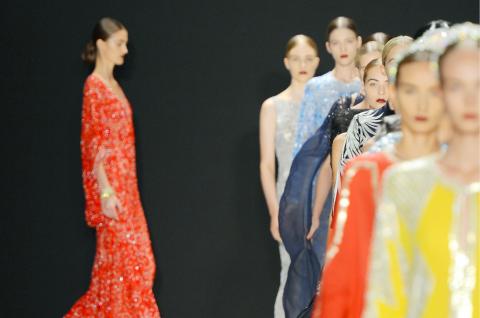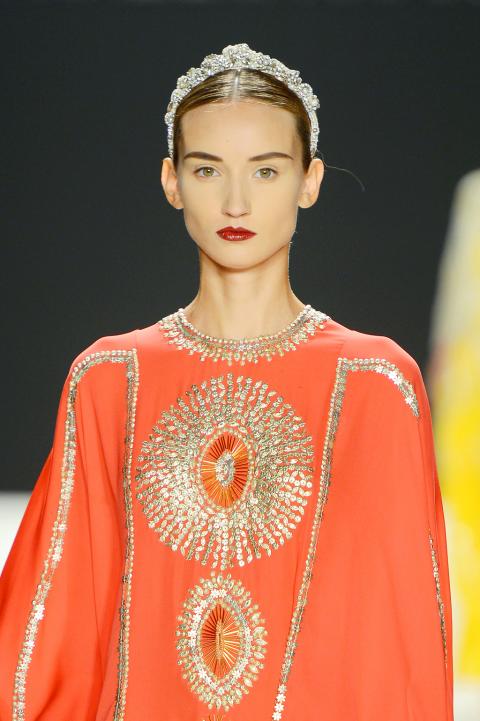The lunar moth. Oscar Wilde. Eighteenth-century Japanese scrolls. An obscure Bauhaus artist. Antique porcelain. Quick, what do these things have in common? Don’t know? Try this: The Duchess of Windsor. The Arab Spring. The Beatles’ 1960s encounter with the Maharishi. A Midsummer Night’s Dream — not the play, silly, the 1935 movie. The dragonfly.
Give up? OK, we’ll tell you — each of these things was a declared “inspiration,” or theme, for fashion designers this year as they plied their wares at New York Fashion Week.
Why do designers even need such a thing, the uninitiated may ask? Well, many say it helps them organize their thoughts as they travel through the creative process. “It’s the kernel that makes the popcorn grow,” says Jeremy Scott, whose typically outrageous designs attempted to channel the Arab Spring this year, with some Harlem added in (more on that later).

Photo: AFP
But there’s also the pesky issue of having a good answer ready backstage, when you get that inevitable question as the cameras flash and the tape rolls: “What inspired you?” And you can’t just say, “I wanted to make pretty clothes.”
Which is frustrating to veteran designer Nanette Lepore. “Actually, sometimes it annoys me that everyone wants a theme!” she says. “I mean, it really does help when I have a strong one to work with. But often, what you have is just a few notions.”
At the shows that ended Thursday in New York, a number of over-arching mini-themes emerged. For example: Insects. As in, the luna moth, which lives for only a week. Indian-born designer Bibhu Mohapatra saw one, and it became the inspiration for his spring collection. “The luna moth is like a woman — she is constantly evolving,” he said backstage.

Photo: AFP
For Sophie Theallet, another rising designer who has dressed Michelle Obama, it was another insect who stirred her creative juices: the dragonfly. “It’s viewed differently by different cultures, sometimes as evil, sometimes spiritual,” she said. “I wanted to show how the woman I am dressing can be anything at any time.”
Speaking of time, some designers dig way back into it for their themes. Mary-Kate and Ashley Olsen, for example, designers of The Row, were inspired “by the 18th century scrolls of Ito Jakuchu, depicting the Japanese traditions of bird-and-flower paintings.”
Not bad. But Thom Browne will take your old scrolls, Olsen twins, and raise them one obscure German artist from the Bauhaus school. Browne’s show — an elaborate performance, really — was an homage to a 1920s artist and choreographer named Oskar Schlemmer.
From Bauhaus to Dadaism: Designer Phillip Lim said he was exploring a literary technique — via clothing — used by Dadaists in the 1920s and William S. Burroughs in the 1950s. Not to ignore the 60s, Marchesa designers Georgina Chapman and Keren Craig channeled the Beatles’ visit to the Maharishi in India.
And Reem Acra, who designs glamorous evening gowns, said she was inspired by contemporary sculptor and artist Aaron Young and his motorcycle-themed work: “The abstract and destructive energy of his pieces are taken to create a defined, sophisticated and compelling statement on femininity.”
Some designers prefer current events, as Scott did with the Arab Spring. This acknowledged bad boy of the fashion world had long veils to go with see-through dresses, some Arab headdresses — paired, of course, with thigh-high alligator boots — and, to dress up that tired tank top, a slew of metallic mini-M16 automatic rifles.
Sometimes a show’s theme is less in-your-face, er, clear. Watching last year’s Rodarte spring show was like slowly solving a puzzle. A sunflower print here, a painter’s smock there, some “midnight blue” — only afterwards did the Mulleavy sisters, the much-admired designing duo, reveal that their theme was, of course, Vincent van Gogh.
This year the Mulleavys, asked their inspiration, said it was “medieval and role playing games.”
Like them, Wes Gordon was partial to corsets this season. But the young designer wasn’t thinking medieval. “A high priestess,” he pronounced immediately, when asked his theme. “A woman who’s powerful, alluring and feminine, but at the same time dark and sinister.”
Are you an old-movie buff? Mark Badgely and James Mischka had a show for you. Their spring theme was the 1935 film version of Shakespeare’s A Midsummer Night’s Dream, starring James Cagney.
And they weren’t the only designers thinking about that Shakespearean play. The Dream,’ a ballet inspired by the play and danced by American Ballet Theatre, was the theme of Christian Siriano’s spring collection. The fourth-season winner of Project Runway said he tried to recreate the ballet’s tulle-filled, pastel-colored fairytale world.
Straightforward enough. Sometimes, though, it’s a little hard to get the connection, not just between a designer’s inspiration or theme and their clothes, but even between the different elements of the theme. To wit, designer Naeem Khan’s theme: “The Duchess of Windsor: Exotic Gardens, Fiery Skies, and the Arabian Sea.”
So what’s the link between Wallis Simpson and those other things?
Maybe not much. “When you’re designing a collection, you can be super-focused on one thing or you can go a little wider,” Khan, who designed a shimmering state-dinner gown for Obama, told an audience later. “This collection went a little wider.”
Lepore can relate to that. The ebullient designer literally danced offstage following her runway show. Backstage, her many themes were dancing through her head.
“Well, I was still looking at Oscar Wilde, from last season,” she said. “And we were recently in Ireland, and I was looking at all the greens, so clover was a theme. And of course, there’s the porcelain, those beautiful pieces from the porcelain room at the Chalottenburg Palace in Berlin.”
But wouldn’t it be enough, as she herself mused, just to have some pretty fashion ideas? Like her own lovely mixes of bright green prints with black-and-white checks and stripes?
Reed Krakoff seems to think so. After finding several ways, following his runway show, to say that he was adding sensuality to sporty looks, he concluded: “I don’t really ever have a theme.
“It’s just something that evolves over time,” he said. “It’s about creating something that makes sense. Something that feels right.”

In the March 9 edition of the Taipei Times a piece by Ninon Godefroy ran with the headine “The quiet, gentle rhythm of Taiwan.” It started with the line “Taiwan is a small, humble place. There is no Eiffel Tower, no pyramids — no singular attraction that draws the world’s attention.” I laughed out loud at that. This was out of no disrespect for the author or the piece, which made some interesting analogies and good points about how both Din Tai Fung’s and Taiwan Semiconductor Manufacturing Co’s (TSMC, 台積電) meticulous attention to detail and quality are not quite up to

April 21 to April 27 Hsieh Er’s (謝娥) political fortunes were rising fast after she got out of jail and joined the Chinese Nationalist Party (KMT) in December 1945. Not only did she hold key positions in various committees, she was elected the only woman on the Taipei City Council and headed to Nanjing in 1946 as the sole Taiwanese female representative to the National Constituent Assembly. With the support of first lady Soong May-ling (宋美齡), she started the Taipei Women’s Association and Taiwan Provincial Women’s Association, where she

Chinese Nationalist Party (KMT) Chairman Eric Chu (朱立倫) hatched a bold plan to charge forward and seize the initiative when he held a protest in front of the Taipei City Prosecutors’ Office. Though risky, because illegal, its success would help tackle at least six problems facing both himself and the KMT. What he did not see coming was Taipei Mayor Chiang Wan-an (將萬安) tripping him up out of the gate. In spite of Chu being the most consequential and successful KMT chairman since the early 2010s — arguably saving the party from financial ruin and restoring its electoral viability —

It is one of the more remarkable facts of Taiwan history that it was never occupied or claimed by any of the numerous kingdoms of southern China — Han or otherwise — that lay just across the water from it. None of their brilliant ministers ever discovered that Taiwan was a “core interest” of the state whose annexation was “inevitable.” As Paul Kua notes in an excellent monograph laying out how the Portuguese gave Taiwan the name “Formosa,” the first Europeans to express an interest in occupying Taiwan were the Spanish. Tonio Andrade in his seminal work, How Taiwan Became Chinese,